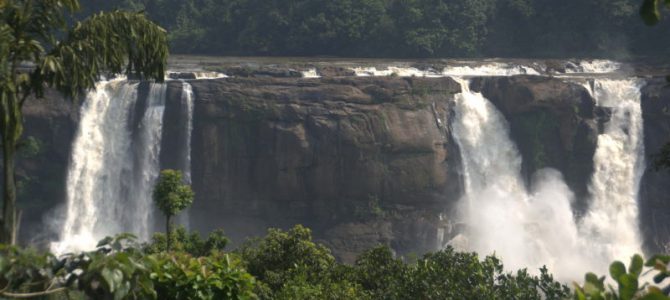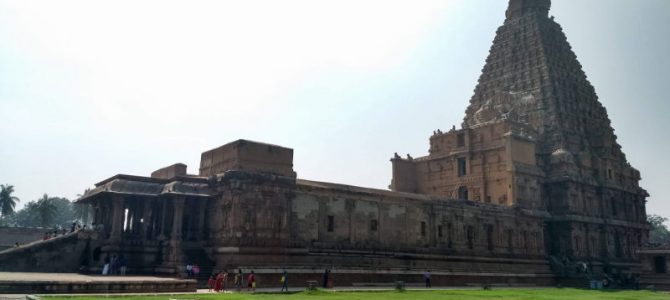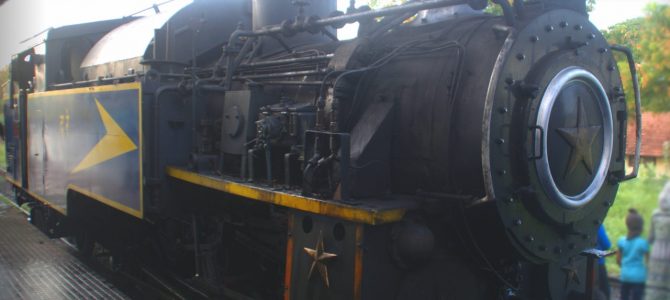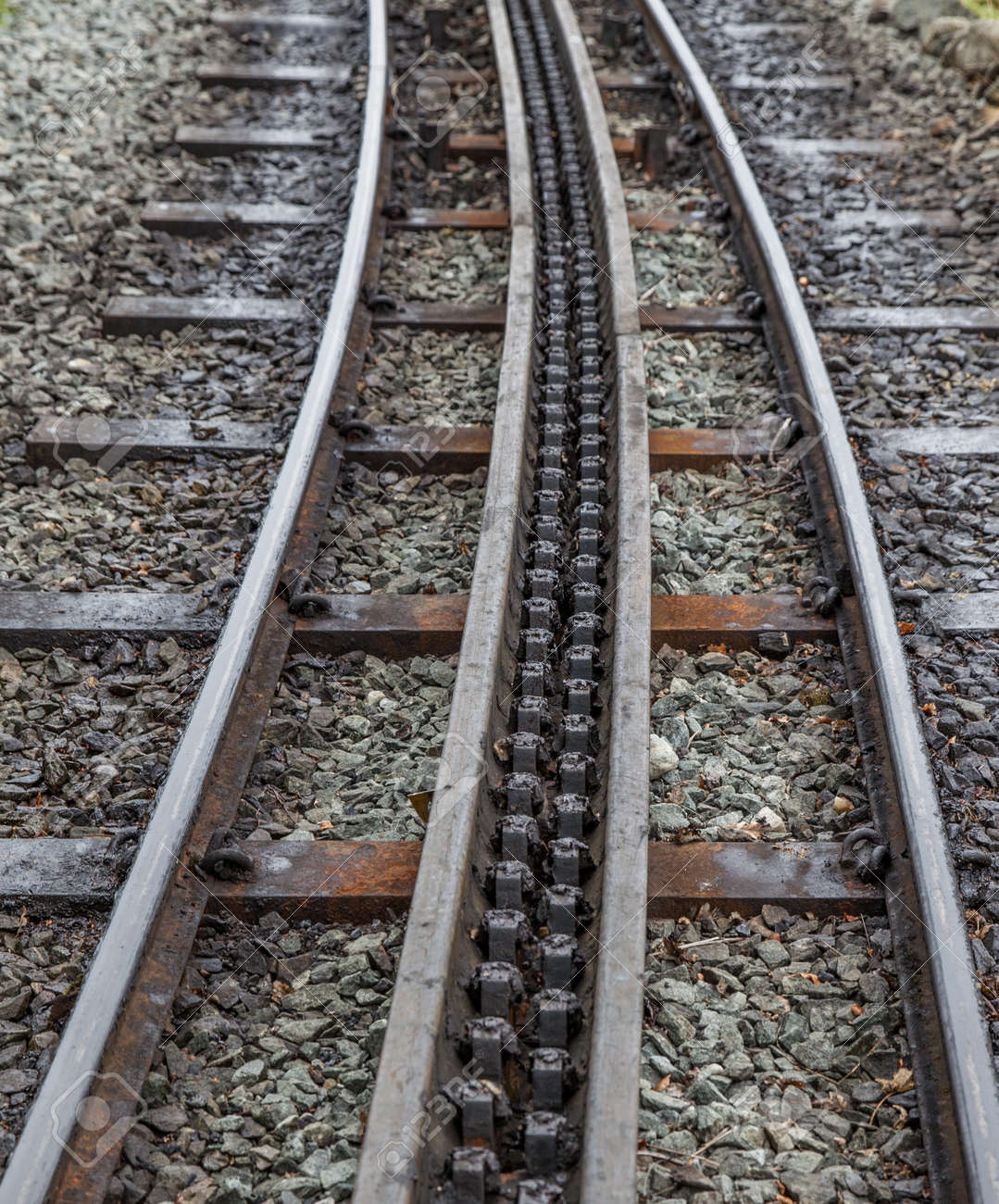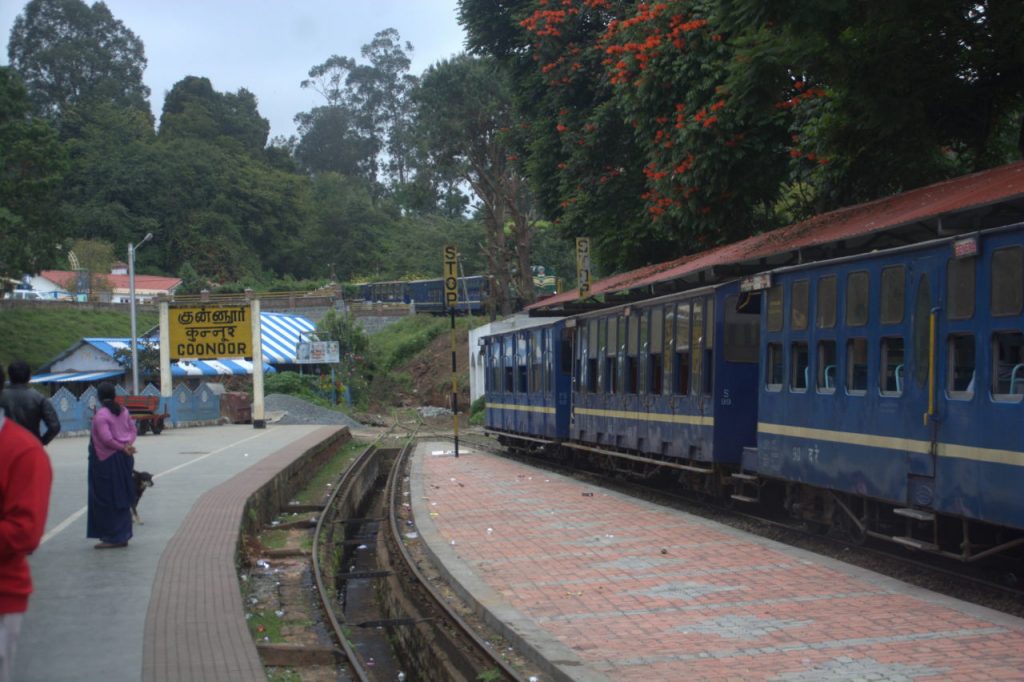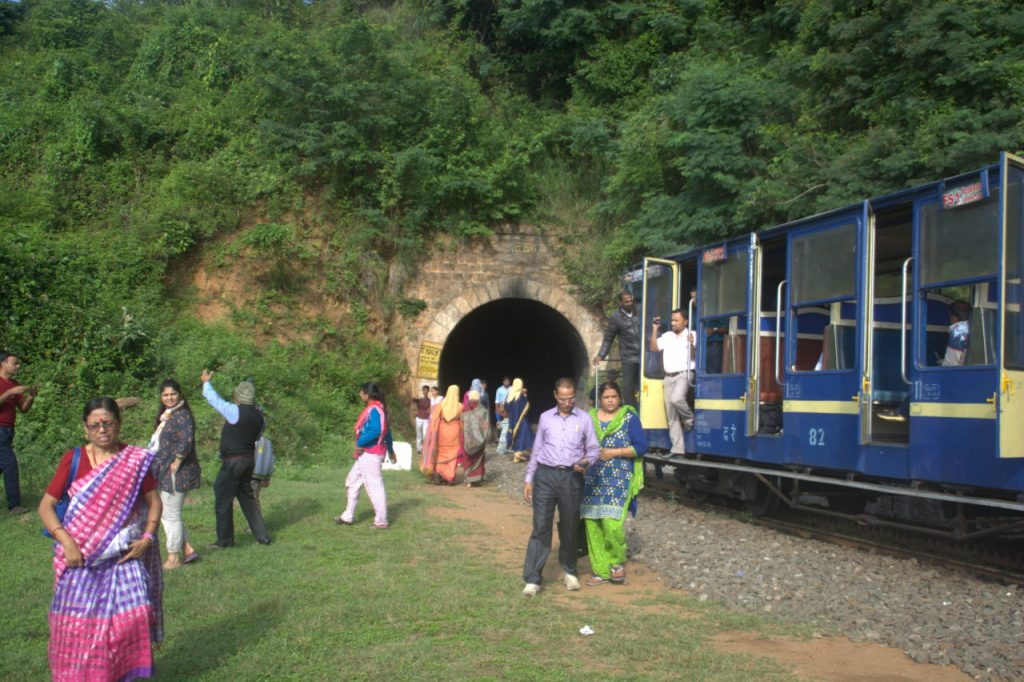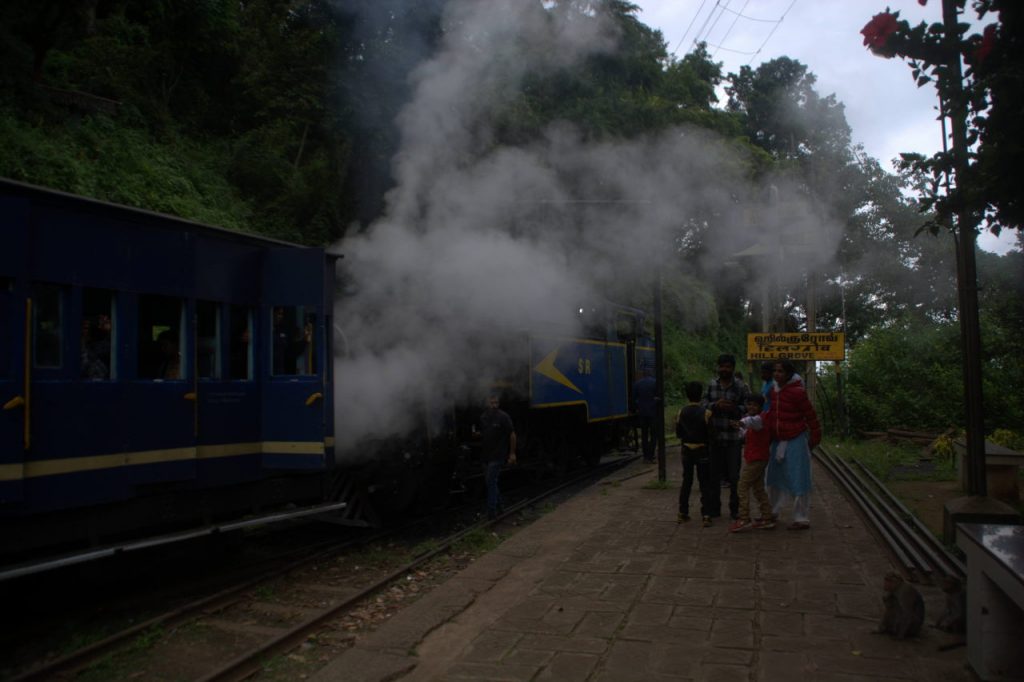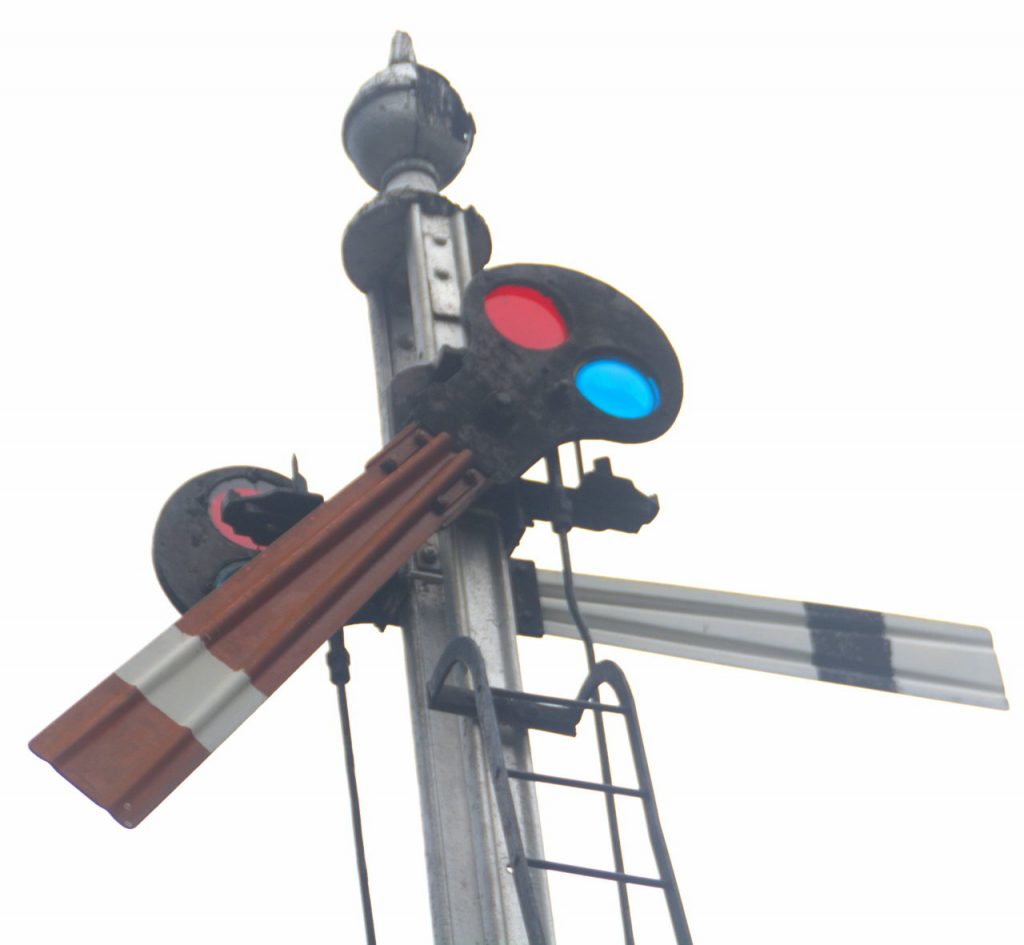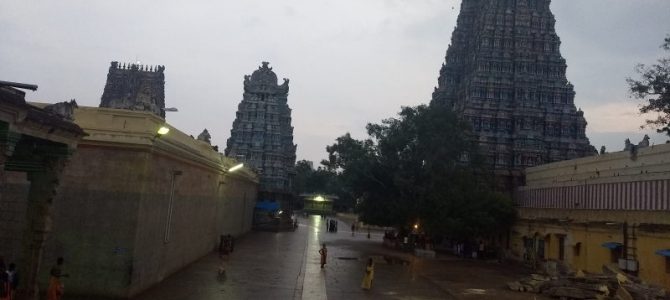Just like Chhatrapati Shivaji for Marathas, Akbar for Mughals and Krishna Devaraya for Vijayanagara, the rule of Rajaraja Chozhan is considered to be a golden period for Tamil Nadu’s Chozha empire (also spelt as Chola empire). Thanjavur or Tanjore was the capital of the Chozhas for a long time and it flourished particularly during the rule of Rajaraja Chozhan. After a short period of uncertainty, the city underwent another cultural renaissance during the rule of the Maratha king Serfoji II. While Rajaraja Chozhan’s time was good for Tamil literature and Chozha architecture, Sanskrit was the main focus of Serfoji II.
Let’s learn more about one of India’s most ancient cities.
Geography of Thanjavur
Thanjavur is the headquarters of the district of the same name. The city is to the south of the five rivers that diverge from Cauvery river to the east of India’s oldest dam — Kallanai or Grand Anicut. The rivers are Kollidam, Cauvery itself, Kudamurutti, Kuruvadi and Vennar. The southern-most of the five, Vennar river is the closest to Thanjavur city.
Thus Thanjavur is part of a very fertile plain. Along with neighbouring Trichy (Thiruchirapally) district, Thanjavur district is one of the biggest contributors to Tamil Nadu’s agriculture sector. For this, both the districts have Cauvery river system to thank.
The land around Thanjavur is flat and one can see no hills or even undulations for several kilometres.
People of Thanjavur
The majority of Thanjavur city is populated by Tamil-speaking Hindus, mainly belonging to the Paraiyar and Vanniyar castes. Most of the people are employed in agriculture, government jobs, medicine, teaching and in private industries that mostly cater to agriculture, such as production of fertilisers, production of irrigation pipes, sugar extraction, husking, etc.
A small section of people in Thanjavur city are descendents of the Maratha rulers and their subjects. While fluent in Tamil, among their own they speak a dialect of Marathi which sounds significantly different from the one spoken in Maharashtra, north Goa and north Karnataka. But because of this option, several contractors from Maharashtra take up temporary work in Thanjavur.
Here are the best places to see in Thanjavur city.
Brihadeeshwara temple
Brihadeeshwara temple is the crowning glory of Thanjavur. It is one of the largest temples in India. The temple is one of the main reasons for Thanjavur to flourish as a tourist centre in Tamil Nadu. Brihadeeshwara temple is a UNESCO world heritage structure.
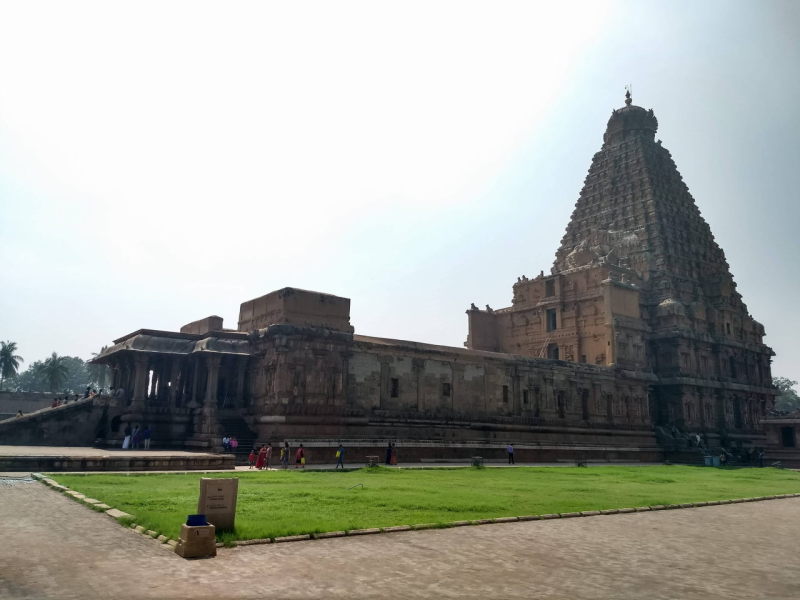
Brihadheeshwara temple
The temple was built during the time of Chozha emperor considered to be the greatest in the dynasty — Rajaraja Chozhan. The temple is also referred to as Rajarajeshwaram. The temple was finished in 1010 AD.
The vimana (main dome) of the temple is an extremely tall 16-storey tapering structure reaching a height of 66 metres (220 feet). The base of the vimana sits on an massive 30 sqm or 100 sqft base. Inside the vimana is the largest monolithic Shiva Linga in the world, measuring 8.7 metres (29 feet) in height. Hence the name Brihadeeshwara (the huge Lord).
The temple sits on a massive courtyard, thus making it the largest temple complex including only temple facilities, in the world. It ranks second behind Srirangam temple of Trichy in terms of area inside temple perimeter, but Srirangam includes the town and the residential area itself inside the temple gates.
Please note that similar to many major Tamil Nadu temples, the main sanctum is closed to public for darshan from 12 pm to 4 pm. So plan a visit either in the morning or in the evening. The temple gates and the courtyard complex remain open during those 4 hours.
Thanjavur palace
Thanjavur palace is the palace of the Maratha kingdom that ruled Thanjavur. The palace was built during the rule of Venkoji, who started the southern Maratha kingdom. Venkoji was a half-brother (brother through another mother) of Chhatrapati Shivaji, the most influential Maratha ruler. After an uncertain period for the Marathas which including plenty of turmoil with the neighbouring kingdoms and foreign invaders, king Serfoji II signed a peace treaty with the British, that forfeited all of Marathas’s conquests to the British, except for Thanjavur district remained under Serfoji II. With peace restored, Thanjavur was able to focus on literature and art yet again, and was peaceful until the annexation by the British in 1800.
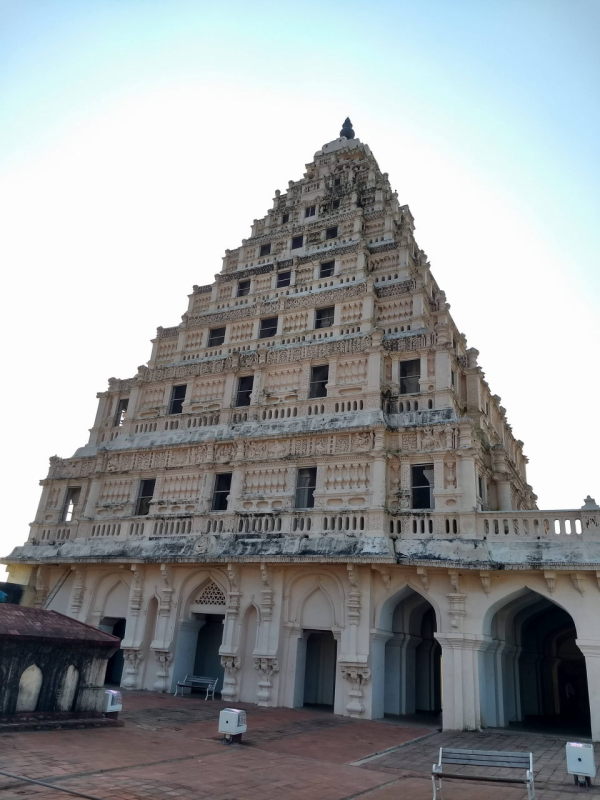
Inside Thanjavur palace
The period of peace was a good one for the palace, especially for the palace’s main highlight, the Saraswati Mahal. This is the royal library that has nearly 50,000 volumes, some of them older than 1000 years. The library has collections from the time when paper was not used as a medium. There are collections in palm leaves and papyrus. The majority of the collection is in Tamil, followed by Sanskrit. The rest are collections written in languages no longer used in India, such as Pali, Magadhi, etc.
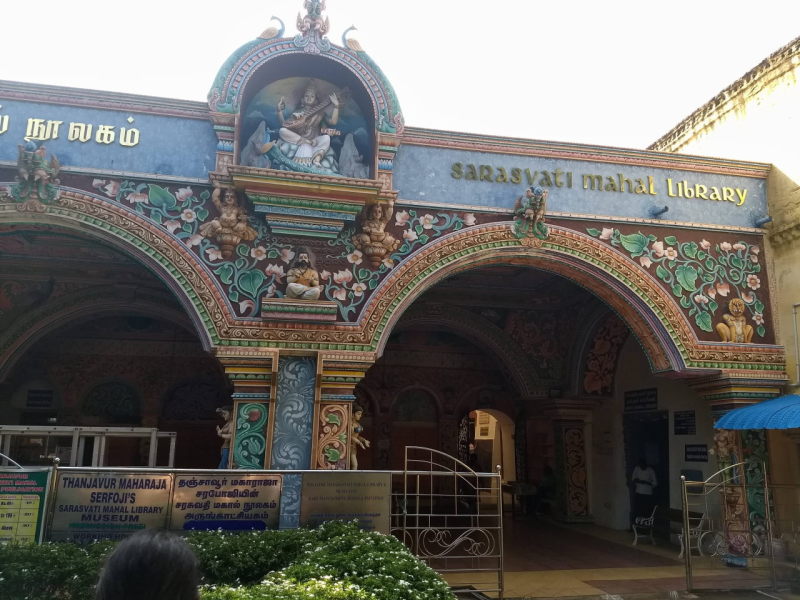
Saraswati Mahal library inside Thanjavur palace
Besides the library, the palace has other points of interest, such as the durbar hall with a statue of Serfoji II, open terraces, a central courtyard and a couple of museums. The museums show traditional Thanjavur artefacts such as the Thanjavur dancing doll and Thanjavur decorative plate.
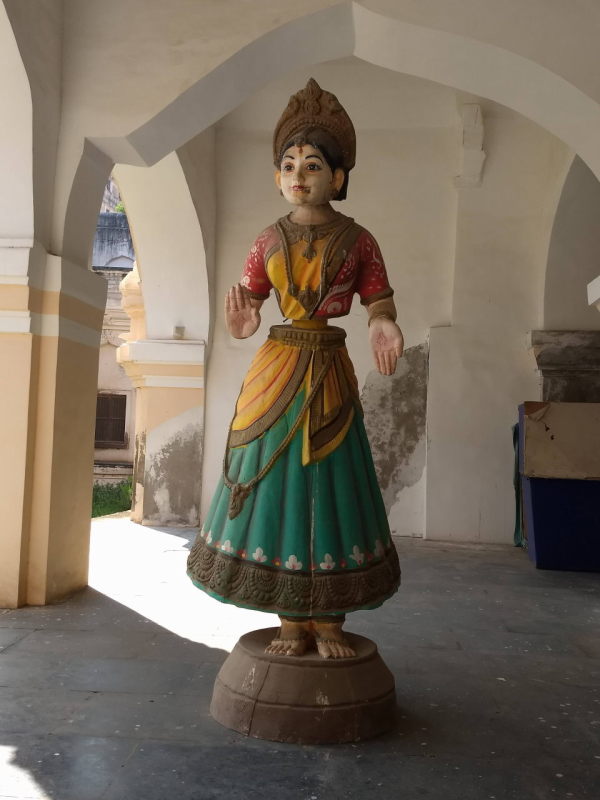
A Thanjavur dancing doll. The neck keeps moving from side to side.
Mani Mandapam
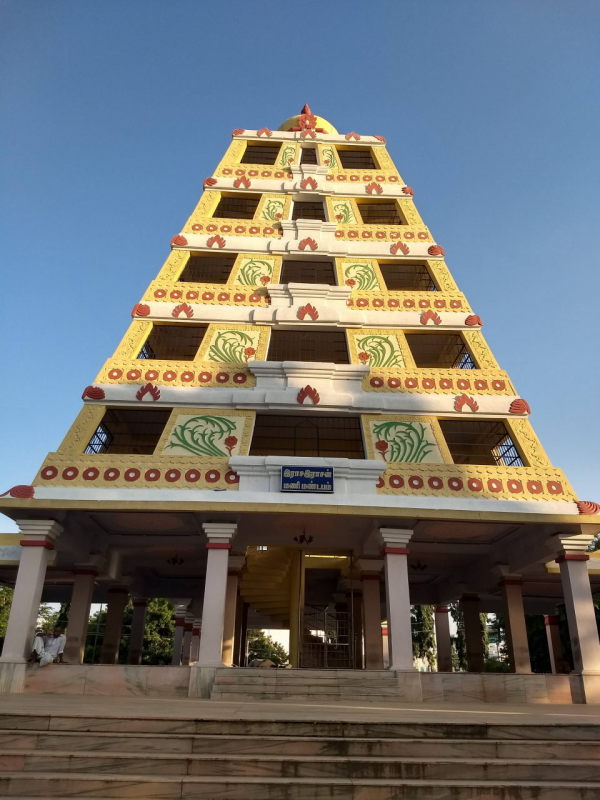
Rajaraja Chozhan Manimandapam, which is also Rajaraja Chozhan museum
Towards the southern end of the city is a triangular park with a tower dedicated to Rajaraja Chozhan. The tower is 5 storeys high and tapering. The park itself has a statue of Rajaraja Chozhan sitting on a prancing horse. At the base of the tower is a museum showcasing Chozha architecture and their lineage.
Also around Thanjavur
It takes a complete sight-seeing day or even two to explore the Brihadeeshwara temple, Maratha palace and Mani Mandapam. But while you are staying at Thanjavur, you can take the opportunity to see some other places of interest, all of them within 50 km of Thanjavur, but in various directions.
Kallanai / Grand Anicut: is India’s first dam built on a river. The dam was built with stones during the time of Karikaalan Chozhan, the king who ruled the dynasty around 0 AD. The dam was built using the strength of several elephants.
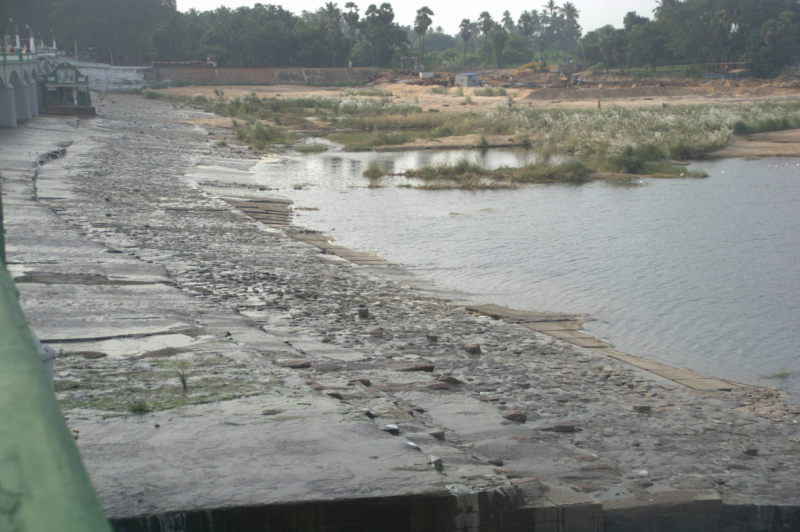
Grand Anicut, one of the world’s first dams.
The dam is on the highway between Thanjavur and Trichy. So if you are headed to Thanjavur from Trichy (like we were), then you get to see this dam before reaching Thanjavur.
Thiruvaiyyaru: The name Thiruvaiyyaru can be broken down as ‘Thiru ai aaru’, which means the ‘five holy rivers’ in Tamil. Read the geography section of this post to learn more about the 5 rivers. This village itself is famous as the town where the Carnatic song composer Thyagaraja sat by the Vennar river and wrote Telugu songs mostly as a devotee of Lord Rama. Every year on Thyagaraja’s birthday as per the Hindu calendar, Carnatic music’s most famous practitioners assemble at the hall of what was once Thyagaraja’s house and recite the songs composed by him. These songs are referred to as ‘Kriti’s.
Swami Malai: On the highway between Thanjavur and Kumbakkonam, just 8 km before the latter, is the temple of Swami Malai, a temple dedicated to Lord Murugan. Swami Malai is one of the six ‘Aruppadai Veedu’s or ‘the six abodes of the Lord’. An interesting thing to observe in Swami Malai is the sixty steps on the stair case that lead to the sanctum. Just like the Chinese calendar repeats in a cycle of twelve years, each year dedicated to an animal (e.g. the pig year, the dragon year, etc), the Tamil calendar repeats in a cycle of sixty years, with each year given a name. Each name repeats once every 60 years. One complete cycle involving sixty years is known as a ‘Sangamam’. In Tamil Nadu, a person who turns sixty is celebrated with a ceremony, since he/she has seen one complete Sangamam.
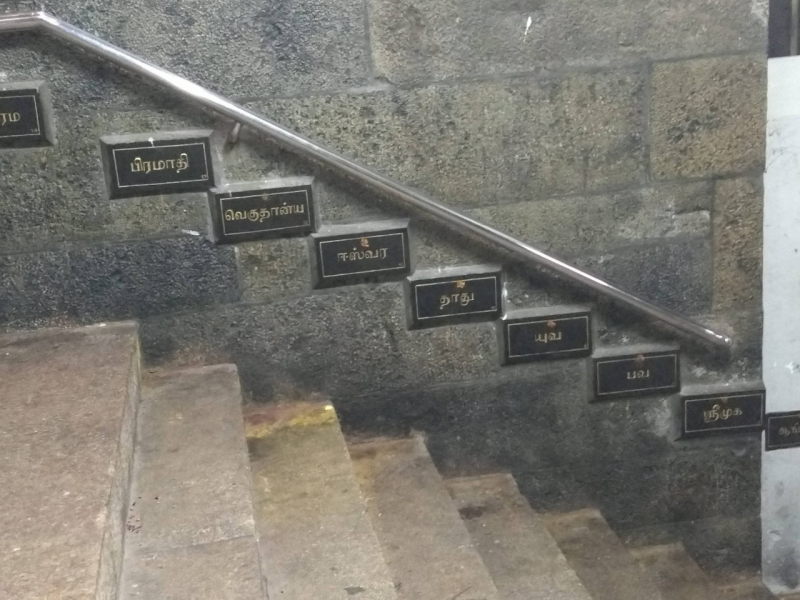
The Tamil Sangamam year names are written beside each step. From top to bottom in this photo are: Bramhadi, Vegudhanya, Ishwara, Naadhu, Yuva, Bhava and Shrimukha.
Kumbakkonam: is a city about 50 km from Thanjavur, known for its various temples. Almost every locality in the city has one major historic temple. The city was built during the time of Rajaraja Chozhan and several temples were later added by successive rulers. At the centre of the town is a pond called the Mahamahan tank, where a festival happens every 12 years. During this festival, people from around Tamil Nadu take a bath in the holy pond to wash off their sins.
Dharasuran: is a village near Kumbakkonam and is home to the Airawateshwara temple, another temple with Chozha architecture. Of particular interest in this temple is the staircase of seven tunes or the ‘Sapta Swara’. Tapping or stomping on the stairs makes sounds, each of them in tune with the Indian musical scale ‘Sa Re Ga Ma Pa Da Ni’. Unfortunately, due to structural damage, these stairs have been fenced off and are now closed to public.
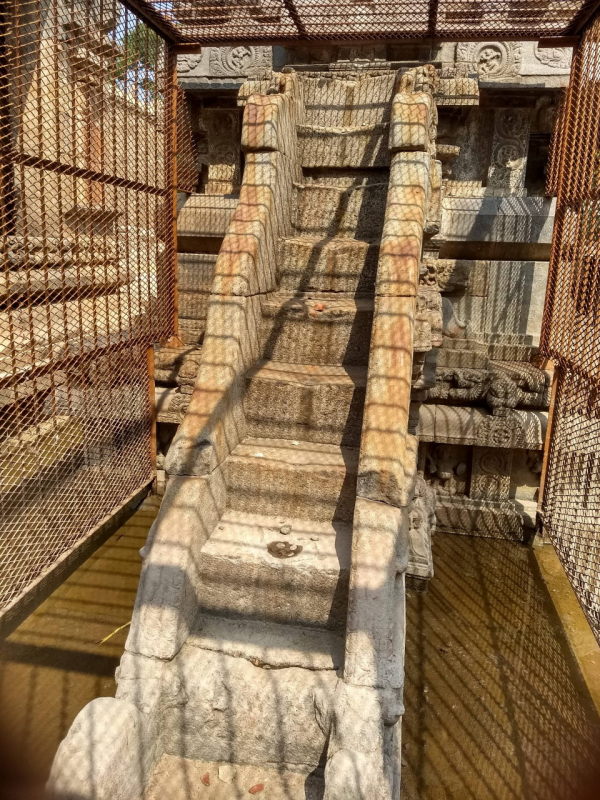
The musical steps, sadly fenced off from the public.
Thiruvarur: was the capital of the Chozha empire during the time of Kulothungan I. It is famous for the Thyagaraja temple, a Shiva temple. The holy trinity of Carnatic music, the three composers, Shyama Shastri, Thyagaraja and Muthuswami Dikshithar, were all born in Thiruvarur. An annual temple chariot festival is held at Thiruvarur every April. The chariot is the largest and heaviest in Tamil Nadu.
Gangaikonda Chozhapuram: Rajendra Chozhan I defeated the Pala dynasty in present day Bihar, Jharkhand and West Bengal. In victory, he collected some water from river Ganga. After his return, he constructed another Brihadeeshwara temple in a town about 70 km north-east of Thanjavur and to the north of Kollidam river, the northern-most of the five. The new temple was also called Brihadeeshwara temple, and the new town, that served as a capital, was named Gangaikonda Chozhapuram or ‘the town of the Chozha who won over Ganga’. Similar to Thanjavur temple, Gangaikonda Chozhapuram temple is also a UNESCO world heritage.
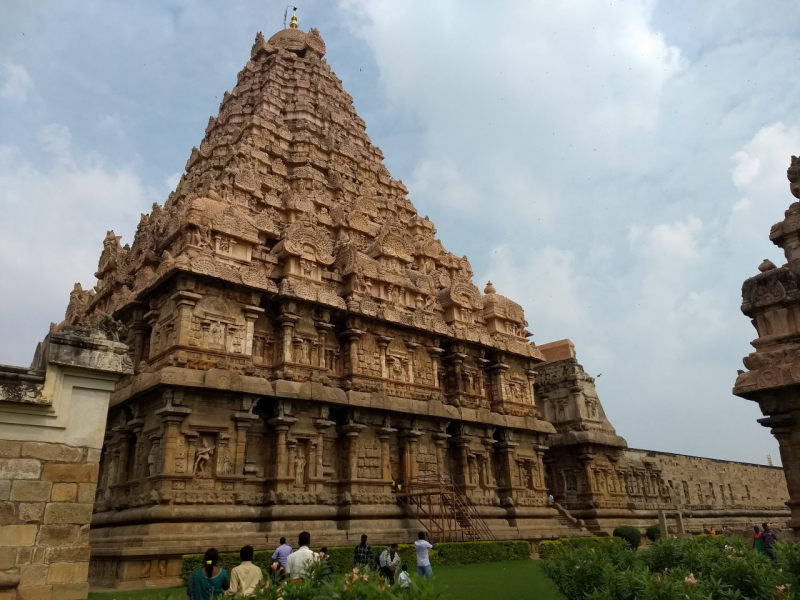
At Gangai Konda Cholapuram
Reaching Thanjavur city
Air: Thanjavur has an airstrip used by the Indian Air Force, but there are no commercial flights. The nearest airport is at Trichy with flights to major cities all over India, the most connected of them being Chennai and Bengaluru.
Rail: Thanjavur Jn is a railway station in the Southern Railway zone’s Trichy division, but is not on a frequently used route. There are two train routes on the route Chennai – Villupuram – Trichy – Madurai. One of them, the ‘main’ line is actually no longer the preferred route. Between Villupuram and Trichy on the main route, we come across several towns such as Neyveli, Chidambaram, Mayiladuthurai (Mayavaram), Kumbakkonam and Thanjavur before reaching Trichy. But because of dense population and the presence of several towns, the speed limit on the route is restricted.
Another route between Villupuram and Trichy is the the chord route, which is straighter, shorter and faster, with only one town, Virudhachalam on the way. Super fast express trains like Pandian Express, Vaigai Express, Duronto and Sampark Kranti prefer this route. The running time is two and a half hours shorter than the main route.
The main route, that passes through Thanjavur, is less favoured by the railways and used by slower trains and passengers. It’s advisable to check the train timetable to decide between a train that covers Thanjavur or rather a super-fast train from which you can alight at Trichy and take a bus to Thanjavur (40 km bus trip). The latter may actually save you time.
Road: Thanjavur is a major bus depot in Tamil Nadu. It is connected to all major cities, with the frequency of buses being particularly high for Trichy and Chennai. One can reach either of the two cities by air or rail and take a bus to Thanjavur.
Self-drive: If you are driving from the east of India, e.g. from north-eastern states, Assam, West Bengal, Odisha or Andhra Pradesh, then you should reach Chennai by joining the Kolkata – Bhubaneshwar – Vishakhapatnam – Rajahmundry – Vijayawada – Nellore – Guduru – Chennai coromandel route. Thereafter, you should use the GST (Grand State Trunk) highway via Chennai – Tindivanam – Villupuram – Ulundurpettai – Perambalur – Trichy highway. From Trichy, take the Trichy – Thanjavur highway.
If you are driving from Kerala, then take one of the following routes: Palghat – Coimbatore, Thrissur – Athirapally – Valparai – Pollachi – Coimbatore, Munnar – Theni – Dindigul. Trichy is about an hour from Dindigul, with both cities being part of Grand State Trunk Chennai – Madurai highway. From Coimbatore, you can use the Coimbatore – Tiruppur – Erode – Karur – Trichy highway. Having reached Trichy, you can drive to Thanjavur on the highway connecting the two cities.
From anywhere else in India, you should join the NH4, i.e. Mumbai – Pune – Satara – Kolhapur – Belagavi – Hubballi – Bengaluru – Hosur – Krishnagiri – Vellore – Kanchipuram – Chennai highway. E.g. People from north India / Delhi / Chandigarh can join at Pune or Mumbai. People from Karnataka can join at Hubballi or Bengaluru. The highway ends at Chennai, but you needn’t go there. Instead, take a detour from Hosur to take the following highways one by one: Hosur – Dharmapuri – Salem, Salem – Namakkal – Karur, Karur – Trichy, Trichy – Thanjavur.
Conclusion
Thanjavur is one of the most ancient cities in India, with its glorious days being during the rule of the Chozhas. After some turmoil, a second innings happened during the rule of the Marathas. Thanjavur continues to be an important city today, with high quality engineering and medical colleges and an Indian Army airstrip. But no other time was greater than the one with the Chozhas. You can travel back in time with just one look at the Brihadeeshwara temple.
